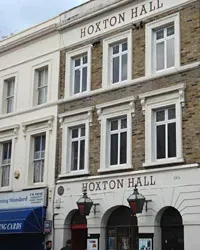Music hall at Hoxton Hall
Written by

By James Hadley in London
Despite the resurgent popularity of cabaret and burlesque, it’s generally felt that their older sister music hall is long dead. It’s a genre which peaked in popularity during the late Victorian era, so most of its performers and trappings are long forgotten and its venues demolished.
Yet in the depths of London’s East End there’s a modest scale music hall venue which has survived urban development. Partly this is probably because much of the East End has had an uninterrupted history of poverty. It’s the only part of London where you can imagine bomb damage from the Blitz still left as it was when the dust cleared.
Hoxton High Street is one of the roughest streets I’ve experienced in London. With no exaggeration, there are drug users and alcoholics sitting in the gutter outside the concrete housing estate, and there are bars over the windows of the job centre as protection against the bricks that might otherwise be thrown through them nightly.
It’s also abundant with salt-of-the-earth Cockney types – consonants are being dropped left, right and centre by the customers drinking their pint outside the pub or queuing at the fish and chip shop. There’s a hard-bitten authenticity to the area that you have to admire, and Hoxton Hall, unobtrusively standing half-way down the High Street, could easily be taken as a monument to this.
It’s been a venue since the 1830s, when it played host to music hall variety shows. It’s not particularly pretty, either inside or out – there’s none of the ornate stucco cherubs and chandeliers you see in the West End. It’s just functional wooden floors and wrought iron railings around its two shallow balconies. The stage is quite small, and two tier, a bit like a church hall stage with another lower stage tacked onto the front. Awkward for a traditional play, but ideal for music hall variety shows.
I first visited the venue for a charming afternoon of reminiscence and sing-along with a group of some of Hoxton’s older residents. Their repertoire of once popular English songs like ‘Underneath the Arches’ and ‘Daisy, Daisy’ with its refrain of ‘you’ll look sweet upon the seat of a bicycle made for two’ brought back memories of what my grandparents used to sing when I was little. Echoes of a quaint, comparatively innocent-seeming England that has almost disappeared from multicultural London now, but can still be traced in other parts of the country.
The theatre company holding the singing session, were doing so as research in the development of their new music hall show about the infamous Vicar of Stiffkey. This eventually became a music hall show called ‘The Missionary’s Position’ which I recently returned to Hoxton Hall to experience.
As the title suggests, it was full to bursting with innuendos, both visual and in verbal puns, and the two women spent much of the show in their underwear while the two men were always fully clothed. So there were hints of Benny Hill, but this was quite appropriate considering the source material. The show was loosely based on the historical figure of the Vicar of Stiffkey, who, in the 1930s, got a reputation for spending too much time with the prostitutes of Soho, supposedly reforming them. When one of the women whom he set up in lodgings made accusations of rape, he was stripped of his ecclesiastical duties, deserted by his wife and children, and reduced to touring in freak show. Until he was mauled to death by a lion. It’s one of those stories so unlikely that it has to be true.
The cast of four included an accompanist on the piano, who would constantly cajole the audience into stock responses like ‘you couldn’t make it up’. This kind of direct address established a flirty relationship with the audience which went hand-in-hand with an awareness that this was a theatre of play acting, and not of suspension of disbelief or realism. Every now and then the performers would break out into a song and dance number, sometimes accompanied by physical antics or visual gags in the manner of a music hall number within an old time variety show. It was very engaging. So much so that it didn’t take much to get the audience to join in on some of the choruses.
This tribute to music hall took you back to a simpler dynamic of theatre, where it was purely about light entertainment. Minimal props and costumes, just a singer or a dancer or an actor doing a party trick that had been polished up into three minutes of audience engagement with a glint in the eye. It does seem decidedly old-fashioned, even if it’s quite a close relative of much musical theatre performance. But it’s charming in its straight-up ‘what-you-see-is-what-you-get’ bravado, as rough around the edges as the East End outside on the streets, and just as easy to respect for its working-class pride and authenticity.